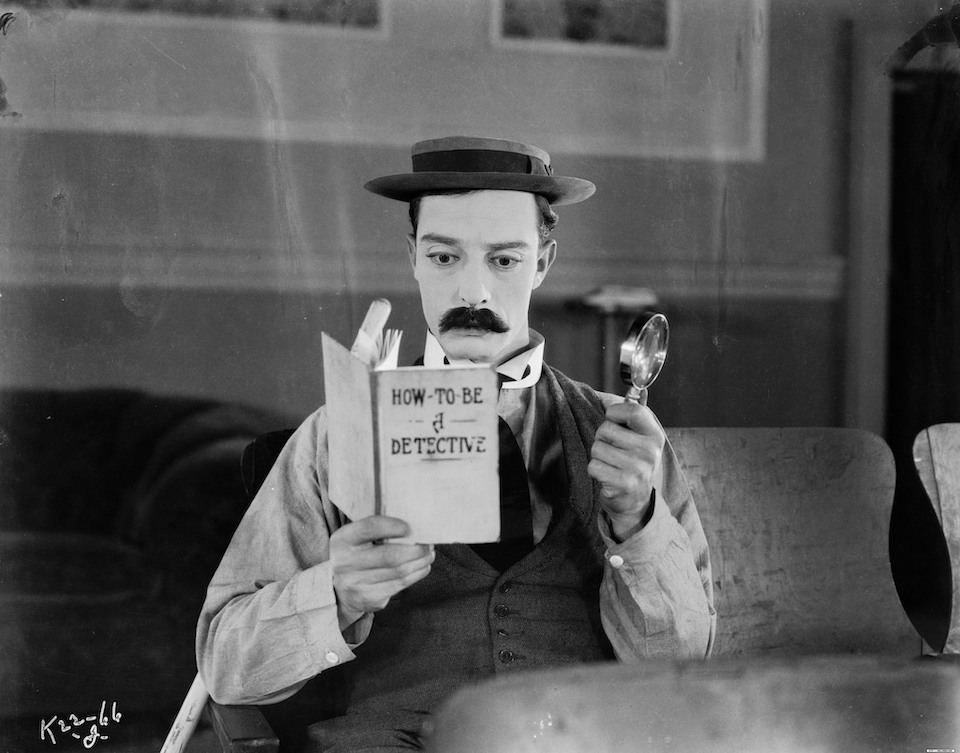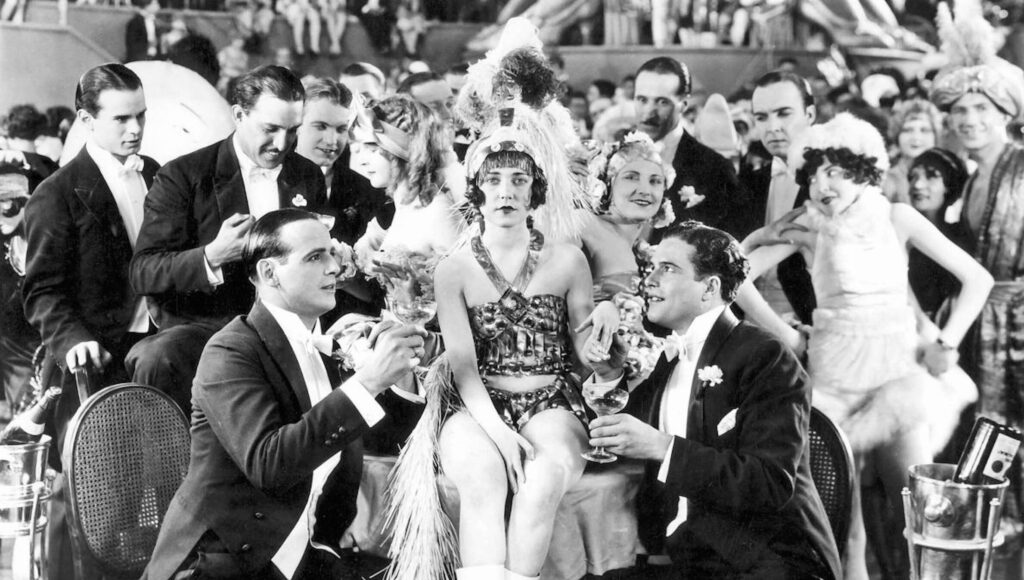
This is now the fifteenth year that Shirley Hughes has been running the Toronto Silent Film Festival, with a terrific program for a few days each spring. In the first few years, it would show films at different venues throughout the week, so that each neighbourhood got a little taste of silent film history. In the past, she has presented films at the Fox (and still does silent programming there at other times in the year), the Royal, Innis Town Hall, and even Casa Loma, with live musical accompaniment on their amazing Wurlitzer organ! In recent years, the festival has exclusively programmed at the Revue Cinema. Although I like the idea of spreading the festival around town, on the other hand it’s nice to see faces become familiar to you over the course of a few days, which best occurs while being situated at one locale. It’s like a communal family that develops!
And speaking of musical accompaniment, I’d be remiss not to mention that each program is accompanied with music performed live, just as they would have been a hundred years ago. This year’s festival featured the talents of Jordan Klapman, William O’Meara, Tania Gill, Morgan Paige-Melbourne, Marilyn Lerner, and Laura Sgroi.
These are but some ways in which the festival becomes an “event”. Some eager patrons even come dressed in vintage 1920s “flapper wear”, or with bowler hats. In addition, there are the ever-popular raffle tickets for some great silent film-related prizes (all proceeds from which go right back into acquiring titles for the next festival).
Yours truly has helped out in previous years of TSFF with editing together some short film pieces, or some digital conversions. The 2023 edition marked the first time I went back to a theatre since the pandemic, and did so by helping out at the festival as “Carlton the doorman” (holding the door open to welcome patrons) and as “Vanna White” (revealing the prizes to be won, and announcing the winning ticket numbers). What a way to go back to theatres again! I had so much fun, that when the call came, I happily volunteered to do it all over again this year.

As always, the 2024 edition provided a selection of old favourites and discoveries. (It seems that with every year, titles from the silent era are being unearthed or remastered.) The festival opened with a sold-out Friday night screening of the legendary Louise Brooks in G.W. Pabst’s classic, Pandora’s Box, featured in a brand-new 4k restoration. I had worked outside as crowd control for this film, ensuring that people lined up properly, so they could get everyone inside and seated as quickly as possible. Alas, it turned out that people were coming in fits and starts, so our job wasn’t really necessary. One hilarious moment did result, though: a woman came up to ask me if I was selling any tickets! Scalpers for Louise Brooks! I love it.
The first of two Saturday afternoon programs featured Douglas Fairbanks in The Mark of Zorro (1920). I had seen this a couple of times on A&E (way back when they still showed Arts and Entertainment), so it was fun to see on a big screen. The feature was preceded by a curious Fairbanks short subject, Mystery of the Leaping Fish (1916), in which he plays a cocaine-addicted detective named Coke Ennyday! Credited as the film’s story writer is Tod Browning, who would figure in the second Saturday afternoon program.

West of Zanzibar (1928) is an enjoyably nasty melodrama, which is one of several collaborations with Tod Browning and Lon Chaney. Unseen by me since it was presented by Guy Maddin in 2003 as part of his “Carte Blanche” series at good old Jackman Hall, it was good to revisit it, and again with a responsive audience. Until now, all of my viewings at TSFF 2024 have been revisits. Now it was time for a discovery.
West of Zanzibar was preceded by the classic 1928 experimental short, The Life and Death of 9413: A Hollywood Extra, by Slavko Vorkapich and Robert Florey. How on Earth had I not seen this film before, although it sits in Mount Unwatched among some avant-garde DVD compilations. Well, serendipitously, it was great to have a first-time viewing in a cinema. This 11-minute film is a new favourite: an incredible melange of representative imagery with spellbinding early work by the great cinematographer Gregg Toland, all shot for a whopping $97! (I’ll revisit and review this film in a future post of its own.)

The first Sunday afternoon program was a showcase of Paris, featuring short subjects, The Talion Punishment (1906), The Fireman of the Folies Bergere (1928 – with a cameo by Josephine Baker!) and a segment on The Seine Flood. An added treat was The Eclipse, or the Courtship of the Sun and Moon (1907) by Georges Méliès, as a nod to the solar eclipse on our continent the week before. The main feature was Ernst Lubitsch’s terrific comedy, So This is Paris (1926). For a silent film, it is amusing that a major plot twist involves hearing a radio broadcast, and that one of its most memorable attributes is the film’s dialogue! (Very funny title cards.) For someone who only knows the sound films of Lubitsch (with the exception of 1919’s Madame Dubarry), this was a major discovery, and a call to check out more of his silent work. (More on this too, in a future post- I hope.)
The 1000 Laffs program for the Silent Film Festival is always a runaway hit, and this year proved no exception. This was the final event for the 2024 festival, and rather fittingly so, which I’ll explain shortly. The theme for this year’s show was Surreal Slapstick, and another reminder that on my fortieth anniversary of cinephilia, I’m still excited that there is much more to learn.

The program opened with another Georges Méliès short, 1909’s amazing Whimsical Illusions, in beautiful hand-tinted colour, which succeeds better than most films in capturing a magician’s act on film, with the illusion of all the effects being done in one single take. Koko’s Earth Control is a 1928 animated short by Dave Fleischer, featuring Koko the Clown and his dog Fitz, playing with levers that control the Earth, causing the planet to go topsy-turvy! Silent comedian Lupino Lane is a recent discovery for me, thanks to a Lobster Films Blu-ray. Only Me (1929) features Lane as a tosspot who goes to the theater one night; the novelty is, he plays all the characters! (Inspired perhaps by Buster Keaton’s short, The Playhouse?) Now You Tell One (1926) is a comedy short with Charley Bowers (another subject for future research), whose plot (Liars Club members compete to see who can come up with the wildest story) as perfect excuse for crazy visual invention.
And then, the feature: Buster Keaton’s masterpiece, Sherlock Jr. (1924), which is one of my top-ten films. I first saw Sherlock Jr. in film school. The class loved it. Professor Doug Davidson, in his trademark light blue suit jacket with yellow stripes, commented on how the film (only 65 years old then) still worked with an audience. Flash forward to this Sunday afternoon. What a thrill it was to hear the laughter of so many kids in the audience, for a film that is now 100! Susan, who had somehow not seen the movie before, called it “amazing”. I hadn’t seen the film in some time, and certainly not on a big screen, and there were some moments I had forgotten until this repeat viewing, in which I would whisper, “Oh yeah, watch this!” (The scene where Buster jumps into a suitcase and emerges out the other side in different wardrobe always gets applause.)

In keeping with the Keaton theme, this show was introduced by Ryan Barnett and Matthew Tavares, who collaborated on the graphic novel, Buster: A Life in Pictures. They were selling autographed copies in the lobby. Naturally I came home with one. (More of this too in a future post – I hope.)
With that amazing screening, the 2024 edition of TSFF came to a close. However, even after saying goodbyes to a few people, the festivities weren’t over yet! (At least, not to us.)
After the movie, we moseyed up to the subway. While we were on the platform waiting for the train, a man and his son walked up to us. We acknowledged each other because we all still had the TSFF lanyards around our necks. Plus the man had recognized me from my stint as “Carlton the Doorman” for this year’s festival prize giveaways. Likewise, I had remembered his son because of the pork pie hat he wore in the cinema. As we all boarded the subway, we got to talking.
They had come all the way from Guelph for the festival, as this young man (maybe 10, 12 years old?) is a huge Buster Keaton fan. When they have their “movie days” at home on a regular Sunday, his son usually picks something by Keaton to watch. What a delight to see a young person so into this. His dad and I shared similar memories of seeing The Little Rascals on Global TV as kids. It gave me hope for continued appreciation of cinema history, if people are introduced to it at a young enough age, just like our generation was.
After a few subway stops later, we got out at our stop, said our goodbyes, as they continued further west. I wish I had gotten their names. Maybe they’ll see this. Otherwise, there’s always next year.